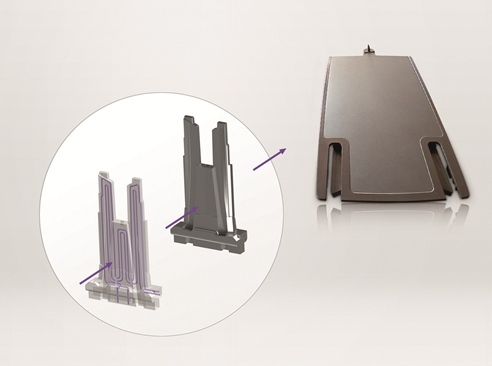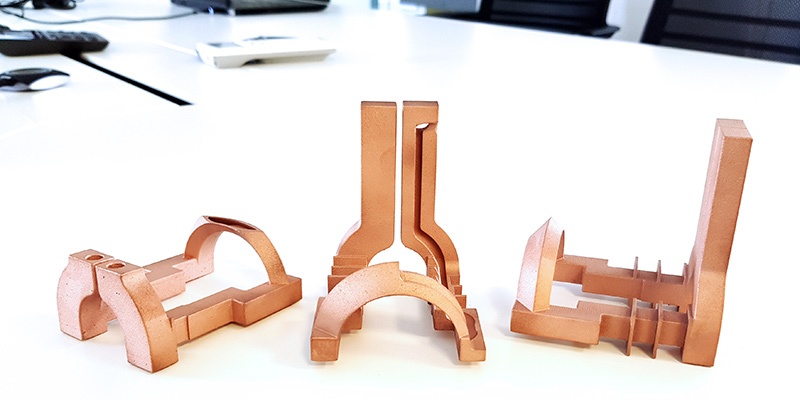The State of 3D Printing in Industrial Goods, Part Five
After exploring the end users, manufacturers and service bureaus involved in the 3D printing of parts for general industrial applications, we’ll be taking a look at the metal materials that are powering that sector. Given its ubiquity in manufacturing and particularly general industry, we’ll start with steel.
An alloy of carbon and iron, steel is known for its high tensile strength and low cost. The industrialization of Asia, particularly China and India, is driving a huge demand for the metal. While 90 percent of the world’s steels are carbon steels, made up of iron and carbon, other alloys are used for a variety of applications.

Tool insert and injection moulding component 3D-printed from maraging steel: thanks to conformal cooling the cycle time was reduced by 17% and the quality of the arm-rest part has been improved. Image courtesy of Innomia, Magna.
Stainless steel, which contain a minimum of 11 percent chromium and often some nickel, are used for their corrosion resistance. Tool steels feature tungsten, cobalt and other carbides to increase their hardness, temperature resistance and ability to receive heat treatment. With just .01 percent carbon makeup, maraging steel features nickel and other elements to create strong but still malleable steel.
While high carbon steels may be used for milling machines, cutting tools, dies and punches, medium carbon steels are typically deployed for structural purposes, such as the body of a machine. Depending on the carbon content, applications for tool steels range from machine parts (on the low end in terms of carbon content) to hammers (medium carbon content) to drills, lathes, dies and razors (high carbon content). Stainless steels are ideal when a part will be exposed to harsh environments, such as corrosive chemicals. Due to their machinability, maraging steels are used for parts that experience a great deal of wear, such as parts for assembly lines and dies.
Titanium is one of the most popular metals in the 3D printing industry, given the technology’s key role in the aerospace sector. Known for its high strength-to-weight ratio and corrosion resistance, the material is used for heat exchangers, tanks, process vessels and valves and other parts that are exposed to volatile chemicals.
Refractory metals (molybdenum, tungsten, niobium, rhenium and tantalum) are a class of metals that exhibit extremely high heat and wear resistance. Because these materials are difficult to work with otherwise, they are best suited for powder metallurgy. Their hardness makes them ideal for cutting tools and casting molds.
The most common nickel-based superalloys in 3D printing are Inconel 625, 718 and HX, which all have nickel and chromium. In addition to featuring oxidization and corrosion resistance, nickel superalloys exhibit high strengths in high temperatures. These materials are heat, oxidization and corrosion-resistant and exhibit high strengths in very elevated temperatures up to 1200 °C. Heavier than titanium, but more heat resistant, nickel alloys are placed closer to harsh environments. For industrial applications, this could mean many parts of machines to process metal and heat treatment equipment, such as muffles, fans, grilles, baskets, reels and radiant tubes. Their high resistance also makes nickel alloys suitable for making molds and dies for molding and casting.
The most widely used non-ferrous metal, aluminum has good strength and hardness, but doesn’t have the same cost as titanium. For AM, the two most common forms are AlSi12 and AlSi10Mg, which are combinations of aluminum and silicon and, in the case of AlSI10Mg, magnesium. Both metals are casting alloys that can be used to 3D print thin walls and complex geometries. As far as the general industrial sector is concerned, aluminum can be used to make processing equipment, pipes, molds, dies and fixtures.
Cobalt-chrome is an alloy of cobalt and chromium, which gives it the properties of high corrosion and wear resistance. This makes it ideal for extreme environments. In terms of industrial equipment, this means saw teeth, turning blades, as well as hardfacing and acid-resistant machine parts, such as valves.
Copper has a unique place in the general industrial sector for its use in the production of induction coils, used to temper metal parts to make them harder. Traditionally, inductor coils are made from machined components that are soldered together in order to create the necessary shape. The more complex the part, the more soldering is required, opening up greater possibility of stress damage. Not only can 3D printing be used to fabricate complex geometries, but 3D printed copper induction coils are actually stronger and demonstrate higher energy efficiency than conventional coils.
While precious metals (gold, silver, platinum, and palladium) have a much more minor role in the general industrial sector, they do have some applications. They are electrically conductive and corrosion resistant, thus opening up the possibility for use in printing electrical connectors, antennas, parts of batteries. These applications have yet to really be explored with 3D printing and precious metals are mainly reserved for 3D printing jewelry and luxury items.
Subscribe to Our Email Newsletter
Stay up-to-date on all the latest news from the 3D printing industry and receive information and offers from third party vendors.
Print Services
You May Also Like
Low-cost “Suzy” Polymer Powder 3D Printer is Faster and Cheaper than Past Models
Polish laser powder bed fusion (LPBF) firm Sinterit has released a follow-up to its predecessors, Lisa and Nils, called Suzy, a $19,490 printer equipped with a 30W fiber diode laser....
India’s $58M Space Fund Is a Boon for AM Innovation
India’s space industry is picking up serious momentum. With a projected $44 billion space economy by 2033, the country is aggressively expanding its capabilities, fostering private-sector participation, and reducing its...
Japanese Advanced Manufacturing Capabilities Grow in Europe with Sodick’s Purchase of Prima Additive
The global economy is currently undergoing a reshuffling in terms of what gets manufactured where. In large part, this trend is being driven by new geopolitical alliances and the need...
Bosch Invests €6M into Serial Auto Part 3D Printing
German industrial conglomerate Robert Bosch GmbH, the world’s largest supplier of automotive parts, has announced a new investment into Nuremberg, Germany additive manufacturing (AM) facility. The nearly €6 million in...




























